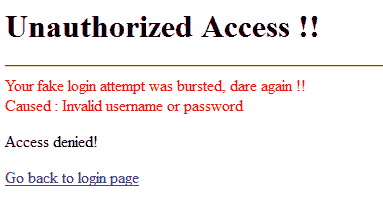Spring Security UserDetailsService示例
原文: https://howtodoinjava.com/spring-security/custom-userdetailsservice-example-for-spring-3-security/
学习在 Spring 应用程序的authentication-provider中自定义UserDetailsService实现,以获取自定义User对象,以及如何在应用程序中使用它。
Spring UserDetailsService接口
UserDetailsService 界面用于为任何给定用户查找用户名,密码和 GrantedAuthorities 。
此接口仅提供实现类需要实现的一种方法:
UserDetailsService.java
UserDetails loadUserByUsername(String username) throws UsernameNotFoundException;
这里 UserDetails 是核心用户信息的容器。 根据文档,出于安全目的,Spring Security 不会直接使用其实现。 它们只是存储用户信息,这些信息随后封装到 Authentication 对象中。 这允许将与安全无关的用户信息(例如电子邮件地址,电话号码等)存储在方便的位置。 一个非常好的示例实现可以类似于 User 类。
在此示例中,
AuthenticationProvider只需通过将UsernamePasswordAuthenticationToken中提交的密码与UserDetailsService加载的密码进行比较,即可对用户进行身份验证。
UserDetailsService实现
1)配置身份验证供应器
我正在提出基于 Spring 登录表单的安全性中编写的代码库。 在application-security.xml文件中,我将更新配置以将EmployeeDao用作自定义用户详细信息服务。
application-security.xml
< ?xml version="1.0" encoding="UTF-8"?>
<beans:beans xmlns="http://www.springframework.org/schema/security"
xmlns:beans="http://www.springframework.org/schema/beans"
xmlns:xsi="http://www.w3.org/2001/XMLSchema-instance"
xsi:schemaLocation="http://www.springframework.org/schema/beans
http://www.springframework.org/schema/beans/spring-beans-3.0.xsd
http://www.springframework.org/schema/security
http://www.springframework.org/schema/security/spring-security-3.0.3.xsd">
<http auto-config="true" use-expressions="true">
<intercept-url pattern="/login" access="permitAll"></intercept-url>
<intercept-url pattern="/logout" access="permitAll"></intercept-url>
<intercept-url pattern="/accessdenied" access="permitAll"></intercept-url>
<intercept-url pattern="/**" access="hasRole('ROLE_USER')"></intercept-url>
<form-login login-page="/login" default-target-url="/list" authentication-failure-url="/accessdenied"></form-login>
<logout logout-success-url="/logout"></logout>
</http>
<authentication-manager alias="authenticationManager">
<authentication-provider user-service-ref="employeeDAO" />
</authentication-manager>
</beans:beans>
2)配置数据源
另外,完整的employee-servlet.xml文件如下所示:
employee-servlet.xml
< ?xml version="1.0" encoding="UTF-8"?>
<beans xmlns="http://www.springframework.org/schema/beans"
xmlns:xsi="http://www.w3.org/2001/XMLSchema-instance"
xmlns:aop="http://www.springframework.org/schema/aop"
xmlns:context="http://www.springframework.org/schema/context"
xmlns:jee="http://www.springframework.org/schema/jee"
xmlns:lang="http://www.springframework.org/schema/lang"
xmlns:p="http://www.springframework.org/schema/p"
xmlns:tx="http://www.springframework.org/schema/tx"
xmlns:util="http://www.springframework.org/schema/util"
xsi:schemaLocation="http://www.springframework.org/schema/beans http://www.springframework.org/schema/beans/spring-beans.xsd
http://www.springframework.org/schema/aop/ http://www.springframework.org/schema/aop/spring-aop.xsd
http://www.springframework.org/schema/context/ http://www.springframework.org/schema/context/spring-context.xsd
http://www.springframework.org/schema/jee/ http://www.springframework.org/schema/jee/spring-jee.xsd
http://www.springframework.org/schema/lang/ http://www.springframework.org/schema/lang/spring-lang.xsd
http://www.springframework.org/schema/tx/ http://www.springframework.org/schema/tx/spring-tx.xsd
http://www.springframework.org/schema/util/ http://www.springframework.org/schema/util/spring-util.xsd">
<context:annotation-config />
<context:component-scan base-package="com.howtodoinjava.controller" />
<bean id="jspViewResolver"
class="org.springframework.web.servlet.view.InternalResourceViewResolver">
<property name="viewClass"
value="org.springframework.web.servlet.view.JstlView"></property>
<property name="prefix" value="/WEB-INF/view/"></property>
<property name="suffix" value=".jsp"></property>
</bean>
<bean id="messageSource"
class="org.springframework.context.support.ReloadableResourceBundleMessageSource">
<property name="basename" value="classpath:messages"></property>
<property name="defaultEncoding" value="UTF-8"></property>
</bean>
<bean id="propertyConfigurer"
class="org.springframework.beans.factory.config.PropertyPlaceholderConfigurer"
p:location="/WEB-INF/jdbc.properties"></bean>
<bean id="dataSource"
class="org.apache.commons.dbcp.BasicDataSource" destroy-method="close"
p:driverClassName="${jdbc.driverClassName}"
p:url="${jdbc.databaseurl}" p:username="${jdbc.username}"
p:password="${jdbc.password}"></bean>
<bean id="sessionFactory"
class="org.springframework.orm.hibernate3.LocalSessionFactoryBean">
<property name="dataSource" ref="dataSource"></property>
<property name="configLocation">
<value>classpath:hibernate.cfg.xml</value>
</property>
<property name="configurationClass">
<value>org.hibernate.cfg.AnnotationConfiguration</value>
</property>
<property name="hibernateProperties">
<value>
hibernate.connection.provider_class=org.hibernate.connection.C3P0ConnectionProvider
hibernate.dialect=org.hibernate.dialect.SQLServer2008Dialect
hibernate.default_schema=dbo
hibernate.show_sql=true
</value>
</property>
</bean>
<bean id="employeeDAO" class="com.howtodoinjava.dao.EmployeeDaoImpl"></bean>
<bean id="employeeManager" class="com.howtodoinjava.service.EmployeeManagerImpl"></bean>
<tx:annotation-driven />
<bean id="transactionManager"
class="org.springframework.orm.hibernate3.HibernateTransactionManager">
<property name="sessionFactory" ref="sessionFactory"></property>
</bean>
</beans>
3)在 Dao 中实现UserDetailsService
现在,我们必须更新EmployeeDaoImpl.java以实现UserDetailsService接口和重写方法loadUserByUsername()。
EmployeeDaoImpl.java
EmployeeDaoImpl.java
package com.howtodoinjava.dao;
import java.util.List;
import org.hibernate.SessionFactory;
import org.springframework.beans.factory.annotation.Autowired;
import org.springframework.dao.DataAccessException;
import org.springframework.security.core.GrantedAuthority;
import org.springframework.security.core.authority.GrantedAuthorityImpl;
import org.springframework.security.core.userdetails.User;
import org.springframework.security.core.userdetails.UserDetails;
import org.springframework.security.core.userdetails.UserDetailsService;
import org.springframework.security.core.userdetails.UsernameNotFoundException;
import org.springframework.stereotype.Repository;
import com.howtodoinjava.entity.EmployeeEntity;
@Repository
public class EmployeeDaoImpl implements EmployeeDAO, UserDetailsService {
@Autowired
private SessionFactory sessionFactory;
@Override
public void addEmployee(EmployeeEntity employee) {
this.sessionFactory.getCurrentSession().save(employee);
}
@SuppressWarnings("unchecked")
@Override
public List<EmployeeEntity> getAllEmployees() {
return this.sessionFactory.getCurrentSession().createQuery("from Employee").list();
}
@Override
public void deleteEmployee(Integer employeeId) {
EmployeeEntity employee = (EmployeeEntity) sessionFactory.getCurrentSession().load(
EmployeeEntity.class, employeeId);
if (null != employee) {
this.sessionFactory.getCurrentSession().delete(employee);
}
}
@SuppressWarnings("deprecation")
@Override
public UserDetails loadUserByUsername(String username)
throws UsernameNotFoundException, DataAccessException
{
System.out.println("Getting access details from employee dao !!");
// Ideally it should be fetched from database and populated instance of
// #org.springframework.security.core.userdetails.User should be returned from this method
UserDetails user = new User(username, "password", true, true, true, true, new GrantedAuthority[]{ new GrantedAuthorityImpl("ROLE_USER") });
return user;
}
}
在上面的 Dao 中,我使用了最少的代码来演示所涉及的类的用法,并且在企业应用程序中,应该对数据库进行适当的访问,并且应该设置用户的密码及其角色。
整个想法是用方法内部的填充值返回User实例。 如果您还有其他要求,那么您也可以自由实现UserDetails接口,并且 spring 不会阻止您使用它。
示例
要测试该应用程序,只需在浏览器窗口中单击 URL “http://localhost:8080/Spring3HibernateIntegration”。 一个登录框将如下所示:
现在,使用正确的用户名和密码(即lokesh和password)登录,您可以进入应用程序,并出现员工管理屏幕。 否则,访问被拒绝的页面将显示如下:
学习愉快!

